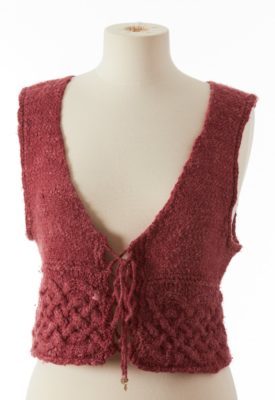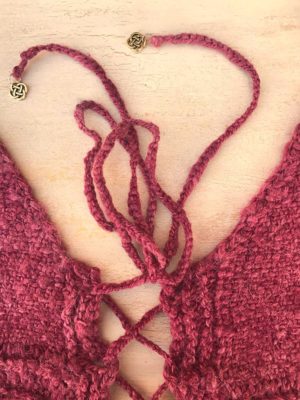Trial and error taught me a lot about dyeing yarn when I made my first handspun vest, and about plying when I made my first handspun socks. These lessons helped me on my second handspun vest, and then textured knitting stitches disguised less-than-perfect handspun yarn.

Plying
For this project, I used (again) my favorite commercial blend of wool and silk, spun worsted singles, and then made a 2-ply yarn. Because my new spinning wheel came with a large-whorl plying head and giant bobbin, I pulled out these accessories every time I plied. However, I didn't know to let twist build up before I released yarn onto the bobbin—essentially, I plied in the same rhythm that I'd used for the singles. My overtwisted singles ended up underplied.
Does insufficient ply twist matter? The answer depends on the yarn's purpose. Since I was planning a vest with knitted cables, tighter twist would have improved stitch definition. (Master spinners like Judith Mackenzie have helped me tweak my plying over the years: her video The Gentle Art of Plying( is a great resource.) Nowadays, that big plying head rarely comes out of its storage box because I can get faster results with smaller whorls.

In addition, plying did not help even out the final yarn, because my singles were still inconsistent: they ran the gamut from fingering to bulky and back to fingering, all in the space of twelve inches! Even worse, thick spots always found other thick spots while I was plying, just as thin parts gravitated toward other thin spots. It's easiest to see the inconsistency in the crochet-chain ties.

Dyeing
Dyeing went much more smoothly this time around, since I used an acid dye and didn't stir the dyebath so much. I did learn that I should tie my skeins more loosely before taking them off the niddy noddy: tight ties prevented the dye from soaking into some of the fiber, creating some undyed patches in the finished vest.
Knitting
This vest pattern (sorry, the details are lost in my memory somewhere) featured linen stitch on the top and a horizontal cable band running around the bottom. These textures worked much better than the stockinette stitch I used on my first vest; the linen stitch tamed the slubbiness so that it looked like yarn with character. The cables looked okay though not stellar, mostly due to underplying and yarn inconsistency. But as with my first vest, I ended up loving the rustic look of my raspberry vest—even if it wasn’t planned!

Next on My List
While I reflected on this vest some twenty years later, I added two things to my "must read/watch" list. Our recent Spin & Knit(https://shop.longthreadmedia.com/products/spinning/top-16-spinning-products-of-2016/spin-off-spin-and-knit-2017) special issue includes Leslie Ordal's article "Got Gauge? (me either)," with helpful tips on spinning for knitting. I also have to watch Beth Smith's video Spinning to Get Even, since I'm still trying to improve consistency.
Next time, we'll look at my first handspun garment to include sleeves! It was a big moment for me.
—Deb

